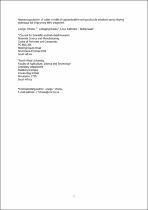 ResearchSpace
ResearchSpace
Nanoencapsulation of water-soluble drug, lamivudine, using a double emulsion spray-drying technique for improving HIV treatment
JavaScript is disabled for your browser. Some features of this site may not work without it.
- ResearchSpace
- →
- Research Publications/Outputs
- →
- Journal Articles
- →
- View Item
| dc.contributor.author |
Tshweu, L

|
|
| dc.contributor.author |
Katata, L

|
|
| dc.contributor.author |
Kalombo, Lonji

|
|
| dc.contributor.author |
Swai, H

|
|
| dc.date.accessioned | 2014-02-13T08:54:08Z | |
| dc.date.available | 2014-02-13T08:54:08Z | |
| dc.date.issued | 2013-10 | |
| dc.identifier.citation | Tshweu, L, Katata, L, Kalombo, L and Swai, H. 2013. Nanoencapsulation of water-soluble drug, lamivudine, using a double emulsion spray-drying technique for improving HIV treatment. Journal of Nanoparticle Research, vol. 15, pp 1-11 | en_US |
| dc.identifier.issn | 1388-0764 | |
| dc.identifier.uri | http://download.springer.com/static/pdf/213/art%253A10.1007%252Fs11051-013-2040-4.pdf?auth66=1392384347_7600ed813a95e3b2c91ef253c8f2adec&ext=.pdf | |
| dc.identifier.uri | http://hdl.handle.net/10204/7201 | |
| dc.description | Copyright: 2013 Springer Verlag. This is an ABSTRACT ONLY. The definitive version is published in Journal of Nanoparticle Research, vol. 15, pp 1-11 | en_US |
| dc.description.abstract | Current treatments available for human immunodeficiency virus, namely antiretrovirals, do not completely eradicate the virus from the body, leading to life-time commitment. Many antiretrovirals suffer drawbacks from toxicity and unpleasant side effects, causing patience non-compliance. To minimize challenges associated with the antiretrovirals, biodegradable nanoparticles used as drug delivery systems hold tremendous potential to enhance patience compliance. The main objective of this work was to load lamivudine (LAM) into poly(epsilon-caprolactone) (PCL) nanoparticles. LAM is a hydrophilic drug with low plasma half-life of 5–7 h and several unpleasant side effects. LAM was nanoencapsulated into PCL polymer via the double emulsion spray-drying method. Formulation parameters such as the effect of solvent, excipient and drug concentration were optimized for the synthesis of the nanoparticles. Spherical nanoparticles with an average size of 215 ± 3 nm and polydispersity index (PDI) of 0.227 ± 0.01 were obtained, when ethyl acetate and lactose were used in the preparation. However, dichloromethane presented sizes larger than 454 ± 11 nm with PDI of more than 0.4 ± 0.05, irrespective of whether lactose or trehalose was used in the preparation. Some of the nanoparticles prepared with trehalose resulted in crystal formation. UV spectroscopy showed encapsulation efficiency ranging from 68 ± 4 to 78 ± 4 % for LAM depending on the starting drug concentration. Fourier transform infrared spectroscopy and X-ray diffraction confirmed the possibility of preparing amorphous PCL nanoparticles containing LAM. Drug release extended for 4 days in pH 1.3, pH 4.5 and pH 6.8. These results indicated that LAM-loaded PCL nanoparticles show promise for controlled delivery. | en_US |
| dc.language.iso | en | en_US |
| dc.publisher | Springer Verlag | en_US |
| dc.relation.ispartofseries | Workflow;12131 | |
| dc.subject | Antiretrovirals | en_US |
| dc.subject | Biodegradable nanoparticles | en_US |
| dc.subject | Lamivudine | en_US |
| dc.title | Nanoencapsulation of water-soluble drug, lamivudine, using a double emulsion spray-drying technique for improving HIV treatment | en_US |
| dc.type | Article | en_US |
| dc.identifier.apacitation | Tshweu, L., Katata, L., Kalombo, L., & Swai, H. (2013). Nanoencapsulation of water-soluble drug, lamivudine, using a double emulsion spray-drying technique for improving HIV treatment. http://hdl.handle.net/10204/7201 | en_ZA |
| dc.identifier.chicagocitation | Tshweu, L, L Katata, Lonji Kalombo, and H Swai "Nanoencapsulation of water-soluble drug, lamivudine, using a double emulsion spray-drying technique for improving HIV treatment." (2013) http://hdl.handle.net/10204/7201 | en_ZA |
| dc.identifier.vancouvercitation | Tshweu L, Katata L, Kalombo L, Swai H. Nanoencapsulation of water-soluble drug, lamivudine, using a double emulsion spray-drying technique for improving HIV treatment. 2013; http://hdl.handle.net/10204/7201. | en_ZA |
| dc.identifier.ris | TY - Article AU - Tshweu, L AU - Katata, L AU - Kalombo, Lonji AU - Swai, H AB - Current treatments available for human immunodeficiency virus, namely antiretrovirals, do not completely eradicate the virus from the body, leading to life-time commitment. Many antiretrovirals suffer drawbacks from toxicity and unpleasant side effects, causing patience non-compliance. To minimize challenges associated with the antiretrovirals, biodegradable nanoparticles used as drug delivery systems hold tremendous potential to enhance patience compliance. The main objective of this work was to load lamivudine (LAM) into poly(epsilon-caprolactone) (PCL) nanoparticles. LAM is a hydrophilic drug with low plasma half-life of 5–7 h and several unpleasant side effects. LAM was nanoencapsulated into PCL polymer via the double emulsion spray-drying method. Formulation parameters such as the effect of solvent, excipient and drug concentration were optimized for the synthesis of the nanoparticles. Spherical nanoparticles with an average size of 215 ± 3 nm and polydispersity index (PDI) of 0.227 ± 0.01 were obtained, when ethyl acetate and lactose were used in the preparation. However, dichloromethane presented sizes larger than 454 ± 11 nm with PDI of more than 0.4 ± 0.05, irrespective of whether lactose or trehalose was used in the preparation. Some of the nanoparticles prepared with trehalose resulted in crystal formation. UV spectroscopy showed encapsulation efficiency ranging from 68 ± 4 to 78 ± 4 % for LAM depending on the starting drug concentration. Fourier transform infrared spectroscopy and X-ray diffraction confirmed the possibility of preparing amorphous PCL nanoparticles containing LAM. Drug release extended for 4 days in pH 1.3, pH 4.5 and pH 6.8. These results indicated that LAM-loaded PCL nanoparticles show promise for controlled delivery. DA - 2013-10 DB - ResearchSpace DP - CSIR KW - Antiretrovirals KW - Biodegradable nanoparticles KW - Lamivudine LK - https://researchspace.csir.co.za PY - 2013 SM - 1388-0764 T1 - Nanoencapsulation of water-soluble drug, lamivudine, using a double emulsion spray-drying technique for improving HIV treatment TI - Nanoencapsulation of water-soluble drug, lamivudine, using a double emulsion spray-drying technique for improving HIV treatment UR - http://hdl.handle.net/10204/7201 ER - | en_ZA |





